Moses In Cradle Care: How to Grow Moses Plant
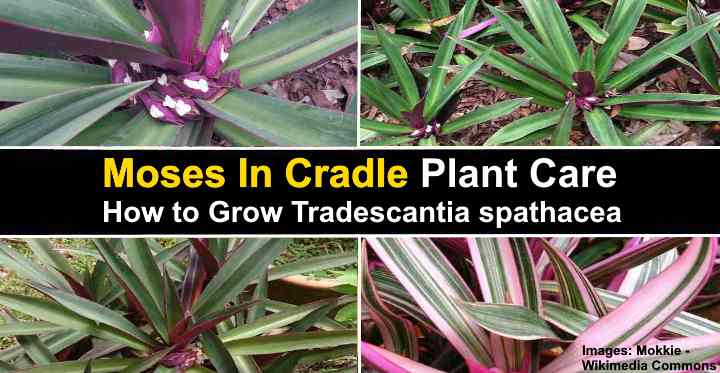
The Moses-in-the-Cradle plant (Tradescantia spathacea) is a pretty houseplant with green and purple leaves. You may have heard the Moses plant called by alternative names such as Boat Lily, Moses-in-a-Boat, Moses-in-a-Basket, Cradle Lily, Oyster plant, and Moses-in-the-Bulrushes. The Tradescantia spathacea used to have the scientific name Rhoeo spathacea.
The common name of this Tradescantia type (Moses-in-the-Cradle plant) comes from the pretty boat-shaped bracts that cradle small white flowers. This delightful indoor plant is easy to care for and adds grace and beauty to most interiors.
How to care for Moses in the cradle plant: To take care of a Tradescantia spathacea, grow in a bright location with partial shade. Keep the potting mix moist by watering when the top 1” (2.5 cm) of the soil is dry. The plant needs high humidity and temperatures between 60°F and 85°F (15°C – 30°C). Fertilize monthly during the growing season.
Moses-in-the-cradle plants are perennial, evergreen, clump-forming plants that grow up to 12” (30 cm) tall. Leaves are in the shape of a sword and are dark green on the upper side and purple underneath. The lanceolate-shaped leaves grow in a rosette pattern, and the flowers appear on the plant throughout the year.
There are several cultivars of Tradescantia spathacea, the most common is the green purple plant. Others include variegated leaves, such as ‘Stripe-Me-Pink’ with green, cream and pink stripes, ‘Vittata’ with yellow and green stripes, and ‘Gold’ with prominent pale yellow bands.
The oyster plant is just one of the 75 types of Tradescantia plants (spiderwort) that you can grow at home. In this article, find how to care for your Moses plant properly.
How to Care for Moses-in-Cradle Plant (Tradescantia spathacea)
The Boat Lily plant grows in most indoor conditions without much fuss. However, to keep the plant thriving and the leafy foliage vibrant, there are a few care requirements you need to observe.
Moses-in-the-Cradle Plant Light Requirements
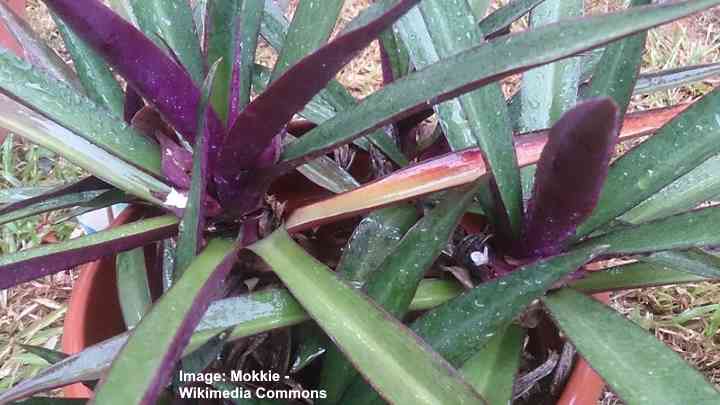
The most popular Moses plant has green leaves with purple underside and it grows best in indirect light
Moses-in-cradle plants need to grow in bright, indirect light to thrive. Put the plant pot in a bright, sunny location, but protected from the sun’s direct rays. To bloom, the Moses plant needs between six and eight hours of indirect sunlight daily. Too much or too little light can cause the leaf colors to fade.
Moses-in-the-cradle is also a plant that grows in low-light conditions. You can place it in a shaded corner of a room or in an office that doesn’t get much natural light. The only thing to be aware of is that their attractive foliage may lose its vibrancy. Also, oyster plants tend to get leggy if they don’t get enough sunlight.
Because the Moses plant can grow in low light but needs high humidity, it can be an excellent houseplant for your bathroom. All you need to do is check the soil for dryness to know when to water it.
The Best Soil for Growing Moses Plants Indoors

In the picture: Moses-in-the-cradle flower
Like most houseplants, the Moses-in-the-cradle plant grows best in light soil with good drainage. The aerated potting mix should contain some peat moss or organic matter to retain some moisture. However, the potting medium shouldn’t stay soggy, or your plant will suffer root rot and eventually die.
An important way to ensure that soil drains well is to use a pot with drainage holes in it. You can also put a layer of stones on the bottom of the pot to assist with drainage. Another reason for poor soil drainage that affects plant growth is if your plant becomes rootbound.
To create the best type of potting mix for Moses plants, combine equal parts of potting soil, peat moss, and perlite. This combination should provide enough nutrients without making the medium too dense. If potting mix consistency is right, water should easily drain from it and not pool on the soil’s surface.
How to Water Moses-in-a-Boat Plant
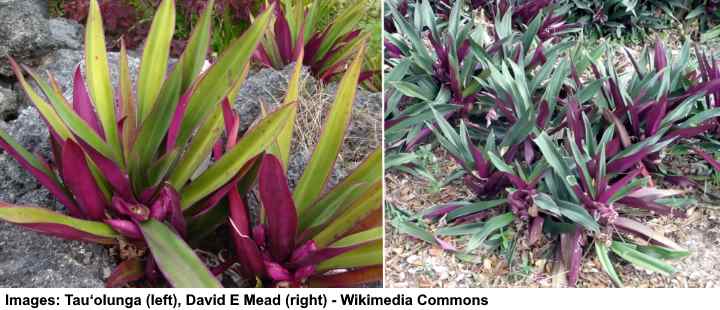
To care properly for your oyster plant, water it when the top soil has dried out
The proper watering technique is key to growing a healthy, thriving Moses-in-the-bulrushes plant. To know when to water your plant, poke your finger 1” (2.5 cm) into the soil. If the soil is dry, it is time to water your plant. If there is any moisture, wait a few days until the soil dries.
Don’t make the mistake of watering your Tradescantia spathacea plant on a set schedule. You only need to hydrate the plant as often as the soil partly dries out. This means that you should water your plant more often in summer and less frequently in winter.
Another mistake that many people make when they water their houseplants is to water often and a little. This watering technique can end up causing your plant to die of thirst because the roots don’t get hydration. Also, you create a damp environment in the top layer of soil. Soil dampness is often a cause of white plant mold and having problems with fungus gnats.
The best way to water your Moses plant is to soak the soil thoroughly every time you water it. Deep watering ensures that the roots are completely hydrated to stay healthy. If you wait until the plant’s soil partially dries until the next time you water, you will never over-water your plant. After the soil drench, let every last drop of water drip out before placing your Moses plant in a bright, sunny location.
The good news with Moses plants is that they are fairly drought-tolerant houseplants. So, you could even go a couple of weeks without watering them, and they should still grow well.
Indoor Temperature for Moses-in-the-Bulrushes Plant

Grow your Moses-in-the-cradle plant indoors in an average room temperature
Average room temperatures are ideal for growing an oyster plant indoors. Keep your Tradescantia spathacea houseplant between 60°F and 85°F (15°C – 30°C). One of the care requirements for Moses plants is to protect them from hot radiators, cold drafts, or direct sunlight.
When growing a Tradescantia spathacea indoors, it’s crucial to remember that they don’t tolerate cold. So, the air temperature should never drop lower than 50°F (10°C). This advice is important if the plant pot is near a window or door during winter. Cold drafts can affect the plant’s growth and even cause it to die.
If you live in temperate climates, you can transfer the Moses plant pot outdoors to a sunny area. Make sure that the plant gets partial shade throughout the day. Also, nighttime temperatures shouldn’t drop below 60°F (15°C). In the fall, take your Moses plant indoors to prevent the cold nighttime air damaging its foliage.
Tradescantia spathacea plants grow outdoors if you live in USDA zones 10 and above. The attractive foliage and spreading growth nature mean that the plant is a good ground-cover plant for partial shade.
Humidity Needs When Caring for Moses-in-Cradle Plant
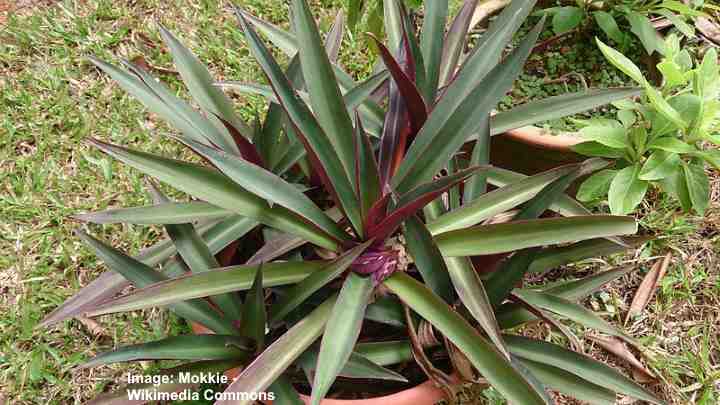
Moses-in-a-boat plant grows best in high humidity
Although boat lily plants prefer high humidity, they should grow in your home without much care. Aim for indoor humidity of at least 40% to prevent discolored foliage and poor plant growth. Household air tends to be drier than outdoors, and your Moses plant will benefit from extra humidity.
If you notice that leaf tips are turning brown, it could mean that the tropical houseplant needs more moisture.
There are several ways you can make the air more humid around your plant. Here are a few care tips:
- Mist the leaves—Spraying a fine mist around the plant can help to increase humidity. Fill a spray bottle with distilled or filtered water and finely spray over the leaves.
- Location—Place the Moses plant in a naturally humid environment. In your home, this could be in a bathroom or kitchen or close to other houseplants.
- Pebble tray—Put a layer of ornamental stones in the bottom of a tray and fill with water until it is half-way up the stones. Place the plant pot on the pebbles for it to benefit from extra humidity.
- Humidifier—A room humidifier can help to keep your indoor environment at an even humid level for houseplants to thrive.
How to Fertilize Moses Plants
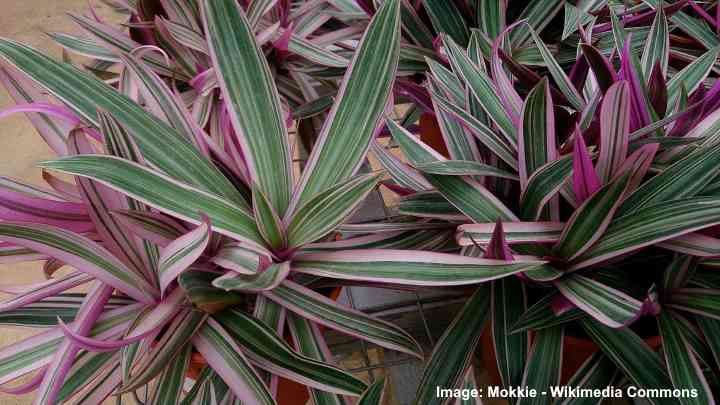
This image shows a variegated cultivar of Tradescantia spathacea with green, cream and pink leaves
The Moses-in-the-cradle plant is a relatively fast-growing plant with modest fertilizer needs. You only need to feed the plant monthly during the growing season—spring and summer. The best type of fertilizer to use is a balanced houseplant fertilizer diluted to half strength. Feeding with balanced nutrients will ensure healthy, fast growth.
Although fertilizer benefits Moses plants, you shouldn’t overfeed the plant. Too much fertilizer is just as bad as watering too often—it can end up killing the plant. So, don’t feed your plant in the fall and winter and cut back on the watering as well.
Many potted indoor plants—the Moses plant included—can suffer from a buildup of mineral salts in the soil. You can encourage healthy growth if you flush the potting mix every once in a while. All you need to do is run water gently through the soil for a few minutes. Once all the water has drained, put the plant back in a bright location. Resume watering when the top 1” to 2” (2.5 – 5 cm) of soil is dry. Resume feeding about four weeks after the soil flush.
Pruning Boat Lilies

Left picture: the common Moses plant with green leaves and purple underside. Right: a variegated cultivar with white and green stripes and purple underside.
Prune back Moses-in-the-cradle leaves every spring to encourage healthy growth. Pinch off the growing tips to help the plant have a bushier appearance. You should also trim off any dead or dying leaves to improve the plant’s appearance. Don’t worry, Tradescantia spathacea is a vigorous grower and will soon look bushy again.
How do you propagate Moses-in-the-cradle?
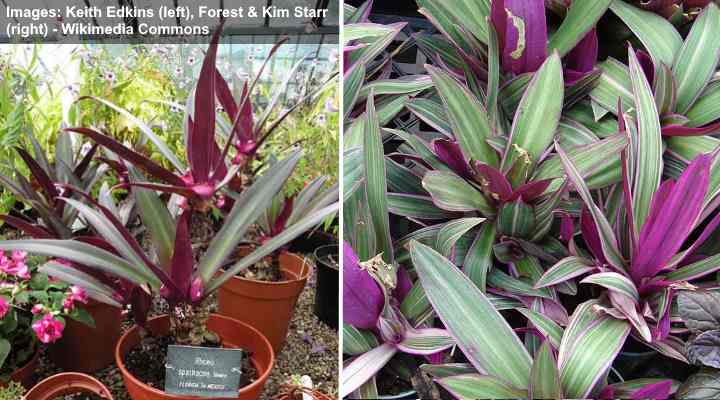
Boat lily plants are easy to propagate
Moses-in-the-cradle propagation is by stem cuttings, root division, or seeds. The easiest way to propagate a Moses plant is by cutting stems or dividing the roots. You may also find that an established plant grows side shoots that can be removed and repotted. In any case, it’s very easy to propagate any type of Tradescantia.
To divide a Rhoeo spathacea or Moses plant, remove a clump of the stems at the roots. Check for any signs of diseased roots. All you need to do is put the new cuttings in a pot containing the appropriate potting soil.
To propagate a Moses plant from stem cuttings, cut a 4-inch (10-cm) section of stem from a healthy plant. Remove the lower leaves and put the stem cutting in a jar of water. After a few weeks, roots should appear. Wait until the translucent roots are about 1” (2.5 cm) long before transferring to a pot.
Repotting Moses-in-a-Basket Plant

Repot your Moses plant every year or two to encourage healthy growth rate
It is usually necessary to repot a Moses plant every year or two when it outgrows the pot. Transferring to a new container also gives you the chance to refresh the potting soil to promote healthy growth. Repotting helps prevent the plant from becoming rootbound and suffering from stunted growth.
When choosing the right size of container, pick the next size up and make sure it’s got drainage holes in it. If the pot is too large, the soil will easily become damp and soggy, and you will get issues with root rot. Also, repotting a Tradescantia spathacea every year allows you to check for signs of root damage.
To plant your Moses plant in a new pot, this is what you should do:
- Gently remove the Moses plant from its container.
- Shake the excess dirt from the roots and run them under water if necessary.
- Untangle the roots and trim off any dead or decaying roots—healthy roots should be white and not mushy.
- Fill a new pot about half-full with fresh, sterile potting mix and place your plant in its new home.
- Fill the remaining space with the rest of the soil.
- Water thoroughly and place your plant in a bright location.
If you are only repotting to refresh the potting soil but don’t want your plant to grow larger, use the same pot. After removing the plant and the soil, sterilize the pot. Trim off about one-third of the roots and repot using a fresh potting medium.
Moses-in-Cradle Plant Care: Dealing with Pests
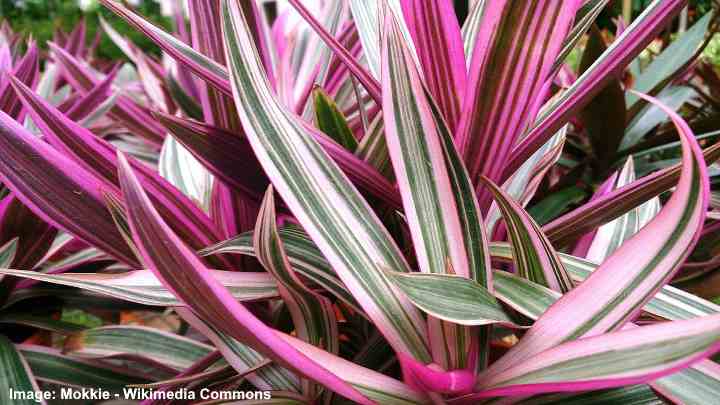
Treat fast any pest infestation you notice on your Tradescantia houseplant
Moses plants—similar to all houseplants—can become victim to houseplant pests. The most common pests to affect these Tradescantia species are mealybugs, spider mites, aphids, and scale. It’s essential to act quickly to get rid of these pests. A pest infestation can eventually kill your plant and spread to other houseplants.
Please read this article for helpful advice on how to identify common houseplant pests.
Many household items are effective in eradicating aphids, mealybugs, spider mites, or scale. You can find some recipes in this article on how to get rid of bugs in houseplants for good.
How to Care for Moses-in-Cradle: Diseases
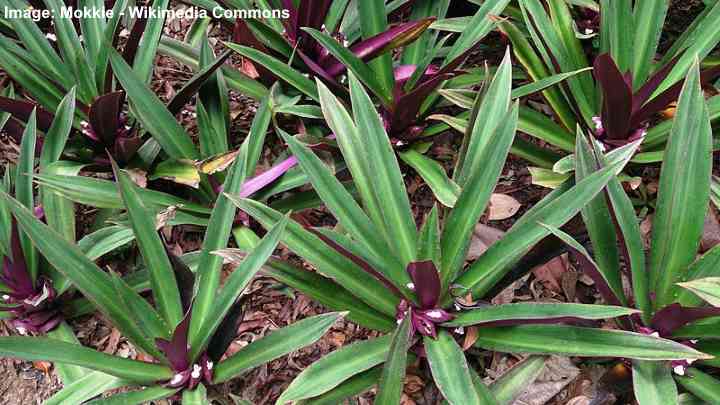
Avoid root rot by watering your Moses plant as often as the top soil dries out
To keep your Moses plant free from disease, always water your plants correctly. The most common disease to affect Tradescantia is root rot—and this is usually avoidable. To avoid decaying and mushy roots, only hydrate your plant when the soil is partly dry.
Check when it’s time to water by firmly pressing on the soil. Only water the plant when there are no signs of moisture on the top part of the soil.
If your plant is showing signs of disease—stunted growth, wilting, discolored leaves—you may need to trim off dead or decaying roots. To prevent any plant disease returning, only water your plant as often as it needs it—when the soil is partially dry.
FAQ About Caring for Moses-In-Cradle (Oyster Plant)
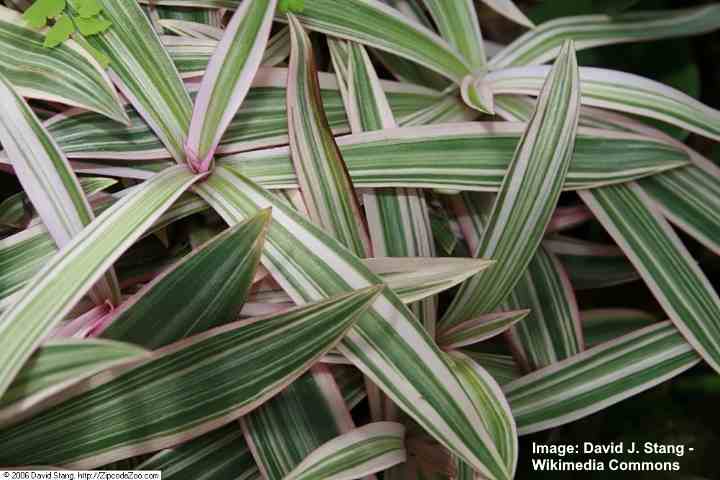
In the picture: variegated hybrid of Moses plant (Tradescantia spathacea ‘Vittata’)
Are Moses Plants Toxic?
Yes, Moses-in-the-cradle plants are can cause skin irritation in cats, dogs, and other household pets. The American Society for the Prevention of Cruelty to Animals (ASCPA) says that Tradescantia plants can cause dermatitis. There are also reports of these plants causing toxic reactions if pets eat a large number of the leaves. (1, 2)
Why is my Moses-in-the-basket dying?
The most common reasons why a Moses plant looks as if it’s dying are due to watering issues, cold temperature, or too much fertilizer. The first thing to check is soil moisture levels. If the soil is too dry, then give your plant a thorough watering. If there is too much dampness in the potting mix, hold off watering until the soil dries out.
Why are the purple leaves losing color?
A lack of sunlight is often to blame for leaves fading. If the green and purple leaves are losing their vibrancy, place the plant in a brighter location. If the leaves have turned yellow, try moving to a shaded location, out of direct sunlight.
Why are leaf tips of my Moses plant turning brown?
Lack of humidity or a buildup of fertilizer in the soil is often the culprit for leaf tips turning brown. Increase humidity around the plant by placing it on a pebble tray. As well as brown tips on the leaves, dry air can also attract spider mites.
If a lack of humidity isn’t the problem, flush the soil to remove the mineral salt buildup.
Related articles:
